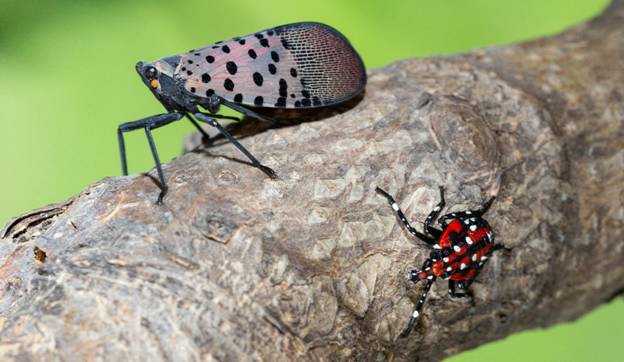URI scientists ask Rhode Islanders to watch for arrival of another invasive insect
Another troublesome invasive species is expected to arrive in Rhode Island this summer, and experts at the University of Rhode Island are asking the public to keep an eye out for it.
The spotted lanternfly,
which feeds on more than 70 different plants and is particularly damaging to
grape vines, is native to China, India and Vietnam and was first detected in
the United States in 2014 in southeast Pennsylvania. It has since spread into
eight other states, including New York and New Jersey, and last year it was
found in several locations in Connecticut.
“We expect it to arrive here imminently; this summer is very possible,” said
Lisa Tewksbury, an entomologist at the URI Biocontrol Lab who monitors invasive
species.
Spotted lanternflies are
sap-feeding leafhoppers, and they look quite distinctive. In their earliest
nymphal stages, they are black with white spots, and later they turn red with
black and white markings. The inch-long adults look like a gray spotted moth
with scarlet hindwings. They can gather in massive numbers, making them a
nuisance even when they aren’t damaging trees and plants.
“We think they’re spreading through the transportation system,” Tewksbury said. “They’re big insects that can fly around and land on trains and other vehicles or get caught in the grills of pickup trucks and end up getting transported to new places.”
The insect’s eggs are
laid on trees – though they have also been found on picnic tables, wood pallets
and even recreational vehicles – where they overwinter and emerge as nymphs in
the late spring. By late summer they transform into adults, and they are easily
seen feeding, flying and congregating in large groups. The adults die after the
first frost.
Spotted lanternflies
seem to prefer to feed on tree of heaven, an invasive tree that scientists
would be happy to have reduced in number. But the insects have also had a
devastating economic impact on vineyards in Pennsylvania. In addition, maple
trees, black walnut trees and ornamental trees and shrubs have also been hard
hit in some areas.
Due to these effects, teams of researchers from throughout the Northeast are studying how to manage these insects. Some efforts are focused on testing the use of horticultural oils and biopesticides that can be sprayed on affected plants and trees.
Tewksbury and her lab manager, Alana Russell, are part of a team testing
whether parasitic insects from China that prey on lanternflies will also harm
native insects if they are released here.
The URI researchers are
also scouting for tree of heaven in Rhode Island to look for evidence of
lanternfly nymphs or adults. That’s where they would like help from the public.
Tewksbury and Russell
are asking for assistance with this surveillance. Those who live near tree of
heaven or grape vines are asked to periodically check them for spotted
lanternflies and to take a photo and collect a specimen if any of the insects
are found. Photos should be sent to Tewksbury at lisat@uri.edu.
More information and a
link to a reporting form for the Rhode Island Department of Environmental
Management can be found at https://web.uri.edu/biocontrol/spotted-lanternfly.
